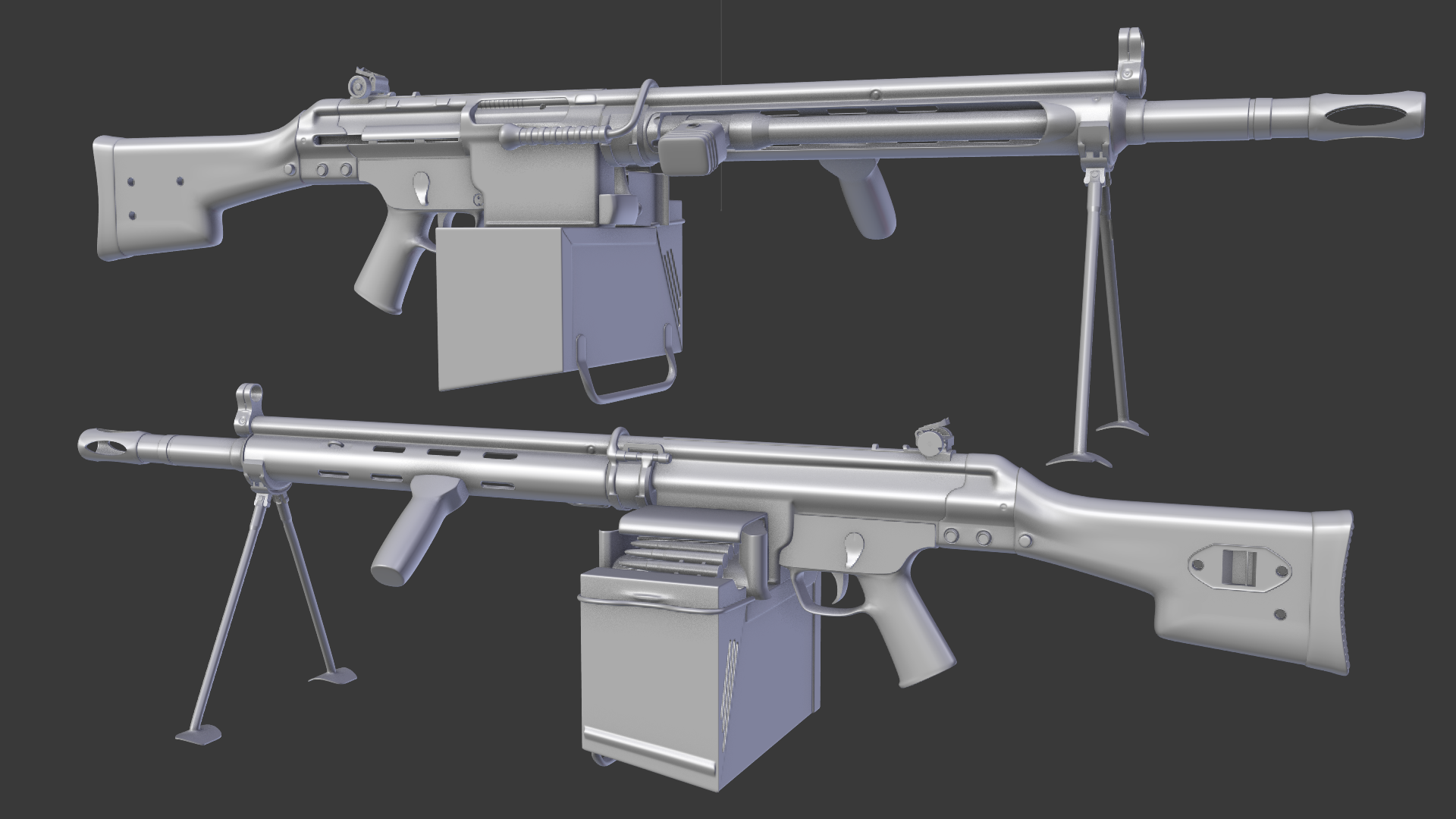project reality PR Guns - M242 Bushmaster (The U.S made 25mm Autocannon)
Note: This is based on my previous post in Militaria section
Q: What again this time? After all this months...
A: Dude, this is all about the 25mm Autocannon, infamous M242 Bushmaster-!
Q: What a surprise! Lemme guess... this thing must be in-game (PR)
A: Oh yeah, of course! Almost all of U.S and N.A.T.O members using it!
The M242 Bushmaster is a 25 mm (25×137mm) chain-driven autocannon. It is used extensively by the U.S. military, as well as byNATO's and some other nations' forces in ground combat vehicles, such as the Bradley fighting vehicle and various watercraft. Originally the weapon was designed and manufactured by Hughes Ordnance in Culver City, CA, which was acquired by McDonnell Douglas (later acquired by the Boeing Corporation); however it is now produced by Alliant Techsystems (ATK) of Mesa, Arizona.
It is an externally powered, chain-driven, single-barrel weapon which may be fired in semi-automatic, burst, or automatic modes. It is fed by a metallic link belt and has dual-feed capability. The term "chain gun" derives from the use of a roller chain that drives the bolt back and forth. The gun can destroy lightly armored vehicles and aerial targets (such as helicopters and slow-flying aircraft). It can also suppress enemy positions such as exposed troops, dug-in positions, and occupied built-up areas. The standard rate of fire is 200 rounds per minute. The weapon has an effective range of 3,000 metres (9,800 ft), depending on the type of ammunition used. With over 10,000 units sold worldwide, it is one of the most successful modern autocannons.
- History:
The Bushmaster project started as an offshoot of the US Army's MICV-65 program that was attempting to introduce a new infantry fighting vehicle to replace their existing M113s. Part of this program called for a new scout vehicle to replace the M114, a parallel development taking place under the XM800 Armored Reconnaissance Scout Vehicle. Both the XM800 and the cavalry version of the XM701 MICV vehicles were armed with the M139, a US-built version of the Hispano-Suiza HS.820 20 mm autocannon. During the testing phase, the Army eventually rejected the XM701 and started work on a newer design known as the XM723. Soon after theXM800 was also rejected. This led to the combination of the two programs, moving the scout role to the cavalry version of the XM723.
program that was attempting to introduce a new infantry fighting vehicle to replace their existing M113s. Part of this program called for a new scout vehicle to replace the M114, a parallel development taking place under the XM800 Armored Reconnaissance Scout Vehicle. Both the XM800 and the cavalry version of the XM701 MICV vehicles were armed with the M139, a US-built version of the Hispano-Suiza HS.820 20 mm autocannon. During the testing phase, the Army eventually rejected the XM701 and started work on a newer design known as the XM723. Soon after theXM800 was also rejected. This led to the combination of the two programs, moving the scout role to the cavalry version of the XM723.
At the same time, the M139 proved to be disappointing and a contract for a new weapon to replace it started as a competitive development in 1972 simultaneously at Ford Aeronutronic Division (self-powered weapon) and Hughes Helicopters Ordnance Division (externally-powered,) under the Summa Corporation as the Vehicle Rapid-Fire Weapons System-Successor, or VRFWS-S.This was essentially a power-driven gun firing similar 20mm ammunition as the HS.820, the power-driven mechanism would ensure operation even in the case of a misfire.
Progress on the VRFWS-S was slow, and eventually resulted in a switch to a much more powerful 25 mm round. Similar delays in theMICV program meant the ultimate vehicles descending from their efforts, the M2/M3 Bradley Fighting Vehicle, did not enter production until 1981, by which point the Bushmaster had matured. Since 1990, there have been several enhancements made upon the weapon, resulting in the Enhanced 25 mm gun.
To date, more than 10,500 weapons are in service. One of the major reasons for this popularity is the extremely reliable nature of the weapon. It has a rating of 22,000 mean rounds between failure (MRBF), much higher than many comparable devices.
XM701 MICV Project XM800T ARSV at Fort Knox M2 Bradley Fighting Vehicle
M3A1 Bradley Cavalry Fighting Vehicle XM721 MICV Project Hispano-Suiza HS.820 Autocannon
- Description:
Unlike most automatic firearms, the M242 does not depend on gas or recoil to actuate its firing system. Instead, it uses a 1 hp (0.75 kW) DCmotor, positioned in the receiver to drive the chain and dual-feed system. This system uses sprockets and extractor grooves to feed, load, fire, extract, and eject rounds. A system of clutches provides for an alternate sprocket to engage and thus allows the gunner to switch between armor-piercing and high-explosive rounds.
The weapon assembly consists of three parts: the barrel assembly, the feeder assembly, and the receiver assembly. The three-part structure makes it possible for a two-person team to install or remove the system (under ideal conditions) despite its considerable total weight.
The M242 weapon system has both electrical and manual fire control and can be operated electrically or manually. In doing so, the gunner can choose from three rates of fire:
(1) Single Shot Semi-Automatic, in which the gunner can shoot as fast as the trigger can be operated, limited only by the electrical drive speed (it cannot be fired faster than High rate).
(2) Low Rate Fully Automatic, in which the weapon fires 100 rounds a minute, plus or minus 25 rounds.
(3) High Rate Fully Automatic, in which the weapon fires 200 rounds a minute, plus or minus 25 rounds.
- Ammunition:
A wide range of ammunition has been developed for this weapon, providing it with the capability to defeat the majority of armored vehicles it is likely to encounter, up to and including some light tanks. The ammunition used in the M242 may also be used in avariety of weapons such as the GAU-12 Equalizer, the French Giat M811, or the Swiss Oerlikon KBA weapon system. It has the capability to fire U.S. manufactured ammunition as well as the NATO equivalents thereof. Primarily though, it fires six types of rounds:
- M791 Armour-piercing discarding sabot with Tracer ( M791 APDS-T )
- 5.7 million rounds produced
- The APDS-T penetrates lightly armored vehicles, self-propelled artillery, and aerial targets such as helicopters and various slow-moving, fixed-wing aircraft.
- M792 High Explosive Incendiary with Tracer and Self Destruct ( M792 HEI-T-SD )
- 5.5 million rounds produced
- The HEI-T can destroy unarmored vehicles and helicopters and suppress antitank missile positions and enemy squads out to a maximum effective range of 2,200 meters.
- M793 Target Practice with Tracer ( M793 TP-T )
- 11.5 million rounds produced
- The TP-T cartridge is a fixed-type, percussion-primed training round that matches the High Explosive Incendiary with Tracer (HEI-T M792) round ballistically. The TP-T's tracer is visible out to 2,000 meters, however, the round has a maximum effective range (accuracy-limited) of 1,600 meters.
- M910 Target Practice Discarding Sabot with Tracer ( M910 TPDS-T )
- The TPDS-T replicates the flight pattern of the M791 Armor Piercing Discarding Sabot with Tracer (APDS-T) round. The TPDS-Tallows units to realistically practice sabot engagements.
- MK210 High Explosive Incendiary with Tracer ( MK210 HEI-T )
- 228,000 rounds produced
- Used by the U. S. Navy in their Mk. 38 naval weapon system.
- M919 Armor-Piercing, Fin-Stabilized Discarding Sabot With Tracer ( M919 APFSDS-T )
- The APFSDS-T round penetrates light armored vehicles, self-propelled artillery, and aerial targets, which includes helicopters and slow-moving fixed-wing aircraft. The dart is made of depleted uranium.
- Variants:
The M242 is currently in use by the United States Army, Navy, Marine Corps, and Coast Guard, the New Zealand Army, Royal New Zealand Navy, the Norwegian Army, the Spanish Army, the Swiss Army, the Canadian Army, the Australian Army and the Royal Australian Navy, the Israeli Navy, Philippine Navy, the Singapore Army and Republic of Singapore Navy as well as several others. Thewide usage results in several variations and modifications on the standard M242 weapon system.
*Ground Vehicles:
The M242 is standard equipment on the U. S. Army M2 and M3 Bradley fighting vehicles, it is also in use on the LAV-25. Before the project was cancelled, the Bushmaster II 30 mm chain gun (a successor to the M242) was used on the Marine Corps'Expeditionary Fighting Vehicle (EFV).
The M242 is also a popular choice of primary armament for armoured fighting vehicles manufactured around the world, such asSingapore's Bionix AFVs and as the Rafael OWS-25 mounted on upgraded M113A2 Ultra IFVs.
USMC Expeditionary Fighting Vehicle Project Singapore Bionix AFV Singapore M113A2 Ultra IFV
*Enhanced 25 mm Gun:
Work on an upgraded weapon began in 1990. In doing so, all three major systems and seven minor systems were improved. The modifications began with introducing a chrome-lined barrel, an enhanced feeder, and an enhanced receiver. The weapon systems also received minor upgrades such as quick-detachable link covers, a larger breech assembly, a high efficiency muzzle brake, longer recoil, an integral round counter, an extended life firing pin and spring, and a triple-spring drive clutch. It was first put to use on theM2A3 Bradley, the fourth version of the M2 Bradley Fighting Vehicle.
*Naval:
In 1977, the U. S. Navy realized that it needed a replacement for the Oerlikon 20mm Mk. 16 series of guns. In 1986, this requirement was satisfied with the introduction of the Mk. 38 Mod 0 weapons system. A derivative of the M242 system, the Mk. 38 consists of the M242 chain gun and the Mk. 88 Mod 0 machine gun mount. It provides ships with defensive and offensive gunfire capability for the engagement of a variety of surface targets. Designed primarily as a close-range defensive measure, it provides protection against patrol boats, floating mines, and various shore-based targets.
 <- Mk. 38 Mod 0 25mm Naval Cannon
<- Mk. 38 Mod 0 25mm Naval Cannon
*Mk. 38 Mod 2:
Recently, several US Navy platforms have been outfitted with a newer version, the Typhoon Weapon System designated Mk. 38 Mod 2, which is remotely operated and includes an Electronic Optical Sight, Laser Range-Finder, FLIR, and a more reliable feeding system, enhancing the weapon systems capabilities and accuracy. In 2006 the Sri Lanka Navy added the M242 to its fleet of Fast Attack Craft.
The system is also in use by the Republic of Singapore Navy's Formidable-class frigate and Endurance-class landing platform dock ship and were deployed as part of coalition forces' port security efforts in Iraq as well as anti-piracy roles in the Gulf of Aden. Aside from that, the Singapore Police Coast Guard's New Coastal Patrol Craft (NCPC) has adopted the system as its main armament.
BAE and Boeing teamed together after a March 2011 contract to add a directed energy weapon to the Mk. 38 Mod 2 gun mount, known as the Mk. 38 Mod 2 tactical laser system. The TLS combines a Boeing-designed solid-state laser with the existing BAE-manufactured Mk. 38 mount to deliver high-precision accuracy against fast surface and air threats including speed boats and unmanned aerial vehicles (UAVs). Laser power levels can be adjusted depending on the target and mission objectives. Originally, the system was armed with a 10 kW laser, but in April 2017 BAE announced they had increased power to 60 kW.
 <- Mk. 38 Mod 2 25mm Naval Cannon
<- Mk. 38 Mod 2 25mm Naval Cannon
*Mk 38 Mod 3:
In April 2012, BAE unveiled the Mk. 38 Mod 3 version of the system mount, developed in collaboration with Rafael. It is visually distinctive from previous versions with its stealthy housing, which also protects the gun from weather and allows for easier access to internal components through large access panels. The Mod 3 mounts a larger Alliant Techsystems Mk. 44 Bushmaster II 30 mm cannon for a 500-meter range increase, as well as a coaxial M2 .50 caliber machine gun. Elevation is increased to +75 degrees for engaging UAVs and helicopters, and ammunition storage is greater at 420 30 mm rounds. Other features include a larger manual fire control panel, an offset mode specifically for firing warning shots, and a surveillance mode where the gun can be pointed away from a target but the EO sensor remains pointed in the target direction. Although it has a high degree of commonality and has the same footprint as previous models, the Mod 3 is 20 percent heavier due to greater ammo load.
- Operators ( Real Life and PR:BF2 inspired 
- Australia
- ASLAV-25
- Canada
- Coyote reconnaissance vehicle
- LAV III APC
- Malaysia
- ACV-300 IFV
- New Zealand
- NZLAV
- Philippines
- GKN Simba AIFV
- M113 APC
- Singapore
- Bionix 25
- M113A2 Ultra IFV
- Spain
- Army: VEC-M1
- United States
- Army: M2/M3 Bradley
- Marine Corps: LAV-25
- Specifications:
| Type | Chain gun |
|---|---|
| Place of origin | United States |
| Service history | |
| In service | 1972–present |
| Used by | See operators |
| Production history | |
| Designer | McDonnell Douglas |
| Manufacturer | Alliant Techsystems |
| No. built | 10,500+ |
| Specifications | |
| Weight | 119 kilograms (262 lb) |
| Length | 2,527 mm (99.5 in)[1] |
| Barrel length |
• Overall: 2,672 mm(105.2 in) • Bore: 2,175 mm (85.6 in) |
| Width | 318 mm (12.5 in) |
| Height | 373 mm (14.7 in) |
|
|
|
| Shell | 25×137 mm |
| Caliber | 25 millimetres (0.98 in) caliber |
| Barrels | Single barrel (progressive RH parabolic twist) |
| Rate of fire | • Cyclic: 200rpm with 1hp or 500rpm with 8hp |
| Muzzle velocity | 1,100 metres per second(3,600 ft/s) |
| Effective firing range | 3,000 metres (9,800 ft) |
| Maximum firing range | 6,800 metres (22,300 ft) |
Sources: wikipedia, tank-enyclopedia, military-today.com and many other sources
Thanks for reading! Hope this helps people who don't really much familiar or understand military, especially those who played PR lately ![]() Feel free to give some comments and impressions below-!
Feel free to give some comments and impressions below-!
- Inch























0 Comments
Recommended Comments
There are no comments to display.
Join the conversation
You are posting as a guest. If you have an account, sign in now to post with your account.
Note: Your post will require moderator approval before it will be visible.